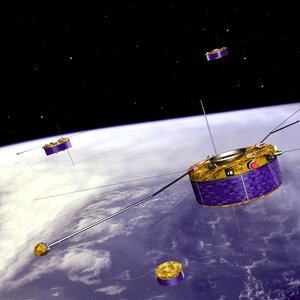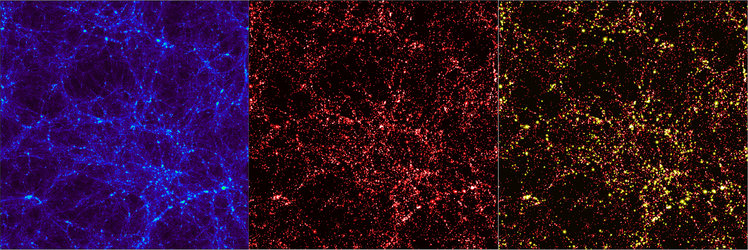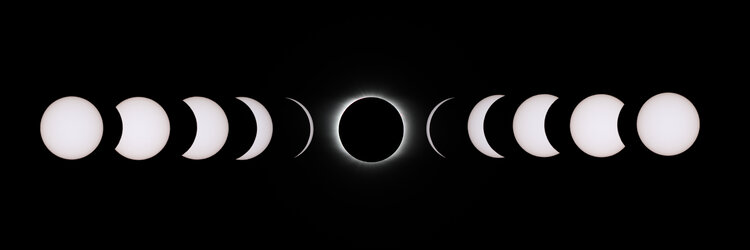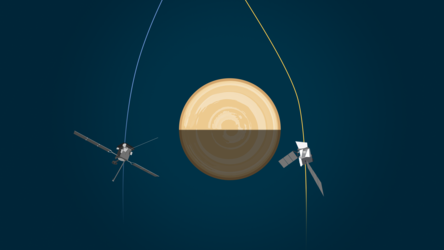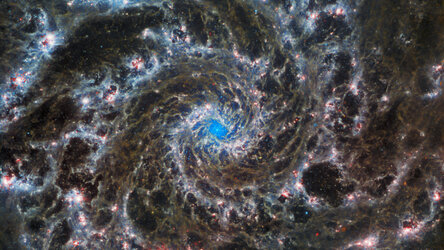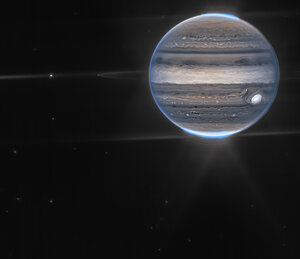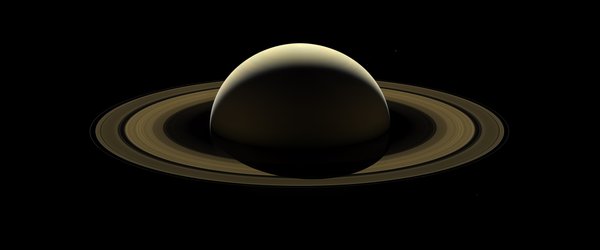S
S-band
A band of radio frequencies extending from 1550 to 5200 MHz.
Sagittarius
Large in size and with many bright stars, the southernmost constellation of the zodiac. Behind its star clouds lies the centre of the Milky Way Galaxy.
Satellite
(1) A small, natural celestial body (such as our Moon) revolving around a larger one.
(2) A man-made object (such as a spacecraft) placed in orbit around the Earth, another planet or the Sun.
Saturn
The sixth planet out from the Sun, famous for its ring system. Saturn, a gas giant, is 9.5 AU from the Sun and has a volume 845 times greater than that of the Earth. The atmosphere of hydrogen and helium surrounds a zone of metallic hydrogen, which covers an ice-silicate core.
Secondary mirror
In a two-mirror reflecting telescope, the secondary mirror sits in front of the larger primary mirror and reflects light to the point at which it will be detected and recorded by an instrument. In simple telescopes, the secondary mirror is flat and bounces the light out the side of the tube to an eyepiece. In more complex and larger telescopes, it is convex and reflects light through a hole in the primary mirror.
Sedimentary rock
Rock formed when rock and mineral particles are deposited and then compressed. On Earth, sedimentary rocks often incorporate material of biological origin.
Separation (satellite)
The instant at which a satellite is released from its launcher.
Serendipity
An event occurring by chance, usually with beneficial or happy consequences.
Service module
Part of a satellite which contains the housekeeping equipment, i.e. power generation, conditioning and control, stabilisation and ground-satellite link.
Servicing mission
Auxiliary mission to have astronauts perform repairs and upgrades to satellite equipment in space.
Seyfert (galaxy)
Type of galaxy with a point-like nucleus and very faint spiral arms, first described in 1943 by American astrophysicist Carl Seyfert. Such galaxies have since been shown to belong to a wider class of objects known as active galactic nuclei.
Shell
A surface made of thin material.
Shoemaker-Levy 9 (comet)
The only comet ever seen to collide with a planet. Discovered by Carolyn and Eugene Shoemaker and David Levy on 25 March 1993 while it was in orbit around Jupiter. After approaching too close to Jupiter, it broke into about 20 separate fragments. These struck the planet 16 - 22 July 1994, creating fireballs which produced dark clouds in Jupiter's atmosphere.
SMART-1 mission
The first of the European Space Agency's `Small Missions for Advanced Research in Technology'. Due to be launched in 2002 towards the Moon, the spacecraft will demonstrate new technologies such as solar electric propulsion to be used on future deep-space missions. See http://sci.esa.int/smart-1/
Solar and Heliospheric Observatory (SOHO) mission
ESA-NASA spacecraft launched in 1995 to investigate the interior of the Sun, its atmosphere and the solar wind. Led to a number of major discoveries about the Sun. See http://sci.esa.int/soho/
Solar array
Panel on a spacecraft used to generate electrical power. It comprises a large number of solar cells which generate electricity when exposed to sunlight.
Solar flare
Sudden violent explosion on the Sun which occurs above complex active regions in the photosphere. They usually last only a few minutes, but their temperatures may reach hundreds of millions of degrees. Most of their radiation is emitted as X-rays, but they can also be observed in visible light and radio waves. Charged particles ejected by flares can cause aurorae when they reach the Earth a few days later.
Solar storm
Violent outburst of explosive activity on the Sun.
Solar System
The Sun and the collection of celestial bodies that orbit it. These include the nine planets (Mercury, Venus, Earth, Mars, Jupiter, Saturn, Uranus, Neptune and Pluto) and their 60 moons, the asteroid belt, the comets and the Kuiper belt.
Solar wind
Stream of plasma, mainly electrons and protons, which flows from the Sun's corona at up to 900 km/s. It is found throughout the Solar System as far away as the heliopause. See also Heliosphere.
Source
Celestial object which emits electromagnetic radiation.
Soyuz (-Fregat) rocket
Russian rocket which has been launched 1500 times since 1963. It is 43.5 m high and can bring a payload of up to 6 tonnes to 400 km. A manned version carries crews to space stations such as Mir, while an unmanned version is used to launch satellites and Progress cargo craft. A fourth stage called Fregat may also be added to the standard three-stage booster.
Spacecraft
Artificial satellite. Term often used before a satellite is placed in orbit around the Earth, when it is transporting something or when it is being sent into deep space.
Space Infrared Telescope Facility (SIRTF)
A NASA infrared space telescope due for launch in 2002. Its main mirror will have a diameter of 0.85 m. It will have a 3-year lifetime.
Space weather
The changing conditions in interplanetary space caused by fluctuations in the solar wind.
Spectral class (of a star)
The spectral class of a star is characterised by the absorption and emission lines that are found in its atmosphere. Each spectral class corresponds to a temperature and is denoted by a letter, from O the hottest and more massive stars to M for the coldest and smallest stars. A mnemonic to remember the series of spectral types is: 'Oh Be A Fine Girl (or Guy) Kiss Me' = OBAFGKM. A new class of stars, designated L, has recently been detected. A spectral class is subdivided into subclasses, designated by a number (0-9). See Hertzsprung-Russell (HR) diagram.
Spectral lines
The lines that appear in the spectrum of an astronomical object. They are an indicator of the chemical elements present in the object, as well as of its physical conditions. See also Spectrograph.
Spectrophotometers
An instrument which determines the energy distribution in a spectrum.
Spectrograph
An instrument used to disperse or separate the light into all its wavelengths which allows quantitative measurements of intensity to be made. As an instrument on a telescope, the spectrograph obtains the spectrum of the light from the astronomical objects. Each spectrum contains a wealth of information. For instance, each chemical element has a distinctive spectrum, which varies with temperature. By analyzing the spectrum of a star astronomers can learn about its chemical composition, its temperature.
Spectrometer
An instrument which measure the position of spectral lines.
Spectrometer (Mossbauer)
An instrument that provides information on the bonding of an atom in a mineral by bombarding it with gamma rays and measuring small shifts in the velocity or energy of the gamma rays emitted. It is most commonly used to identify the nature of iron in a mineral.
Spectrometer (mass)
An instrument for producing ions in a gas and determining their mass and hence composition.
Spectroscopy
Study of a radiation spectrum (emitted, absorbed or diffused).
Spectrum
Electromagnetic radiation whose beam is dispersed like a natural rainbow so that components with different wavelengths are separated in space in order of increasing or decreasing wavelength. There are three kinds of spectra that interest astronomers.
- Continuous spectra: The surface of a star is heated to such an extent that it glows with a particular colour. Red for cool stars, bluish-white for very hot stars. Because the light emitted at the surface has been absorbed and transmitted by many atoms by the time it reaches the surface, the discrete colours of the emission spectra of the atoms have been evened out to form a continuous spectra.
- Absorption Spectra: See Line (absorption).
- Emission Spectra: These usually arise from gas that is in the outer regions of stars, where the light is not absorbed and emitted many times before being transmitted to space. An emission spectrum consists of sharp peaks in the spectrum corresponding to the wavelengths of the emitted light.
Spherical aberration
Image defect caused by a mismatch in the shapes of the reflecting surfaces of the primary and secondary mirrors. Light from different annular regions on the primary mirror comes to a focus at different distances from the secondary mirror, and there is no one position where all of the light is in focus.
Stability (satellite)
Artificial satellite's ability to maintain a constant orientation in space.
Star
Giant ball of gas in space which produces vast amounts of energy through nuclear reactions in its core. There are many different types of stars, which are classified according to their temperatures, colours, ages and compositions.
Starburst (galaxies)
Galaxies in which a large burst of star formation is observed. The characteristic signature of these galaxies is intense emission in the far-infrared waveband.
Stratospheric Observatory For Infrared Astronomy (SOFIA) A NASA infrared observatory on board a Boeing 747. It will have a 2.5 m infrared telescope. To avoid the effect of the Earth's atmosphere, which blocks the infrared radiation, SOFIA will fly at about 13 km. SOFIA's first flight is due in 2002.
Structural and thermal model
Satellite prototype used to test the space performance of the final flight model.
Sublimation
The process by which solids are transformed directly into vapor without passing through the liquid state.
Submillimetre (sub-mm)
Electromagnetic radiation with a wavelength shorter than 1 mm.
Sun
Our nearest star and the central object in the Solar System. Compared with other stars it is fairly average in terms of size and temperature. It seems to have formed from a cloud of dust and gas about 5 billion years ago. A giant ball of gas, mainly hydrogen and helium, it contains 745 times as much mass as all of the planets put together. Energy is generated through nuclear fusion in its core. The temperature of the core is about 15 million degrees Celsius, while the temperature of its visible surface (the photosphere) is 5700 °C. Above the photosphere are the chromosphere and the corona, where the temperature exceeds one million degrees. The energy generated in the core takes 30 000 years to reach the surface, when it is mostly emitted as light and infrared (heat) radiation.
Sunspot
A relatively cool, dark region on the Sun's surface (photosphere) which is created by the Sun's magnetic field. May occur individually or in groups. Number of sunspots increases every 11 years (see Sunspot cycle). The most recent sunspot maximum occurred in 2000.
Sunspot cycle
Periodic variation in the number of sunspots which is related to changes in overall solar activity. The period of the cycle is 10 - 11 years. At the beginning of the cycle there are few, if any, sunspots, but numbers increase as time goes by, then decrease once maximum has passed. This cycle seems to be caused by the interaction between the 'dynamo' which generates the Sun's magnetic field and the Sun's rotation.
Supernova
Explosion of a massive star at the end of its life. Supernova explosions are so luminous that they can outshine a galaxy. There are two types of supernovae. A supernova type I is most likely a white dwarf star in a binary system which accretes material that builds up until a nuclear explosion disrupts the star. A supernova type II is a massive star which has used up all its nuclear fuel. The star then collapses and the impact of all the material produces a shock wave which blasts the outer layers of the star out.
Synchrotron radiation
Electromagnetic radiation emitted by a very high-energy electron, moving in a magnetic field.
Systems engineering review
A review which verifies that the systems engineering (design and construction) of a spacecraft corresponds to the requirements as contained in the design drawings.
Swing-by
A particular manoeuvre that exploits the gravitational force of a moon or a planet to modify the trajectory of a spacecraft and to boost it into space.















 Germany
Germany
 Austria
Austria
 Belgium
Belgium
 Denmark
Denmark
 Spain
Spain
 Estonia
Estonia
 Finland
Finland
 France
France
 Greece
Greece
 Hungary
Hungary
 Ireland
Ireland
 Italy
Italy
 Luxembourg
Luxembourg
 Norway
Norway
 The Netherlands
The Netherlands
 Poland
Poland
 Portugal
Portugal
 Czechia
Czechia
 Romania
Romania
 United Kingdom
United Kingdom
 Slovenia
Slovenia
 Sweden
Sweden
 Switzerland
Switzerland




























